-
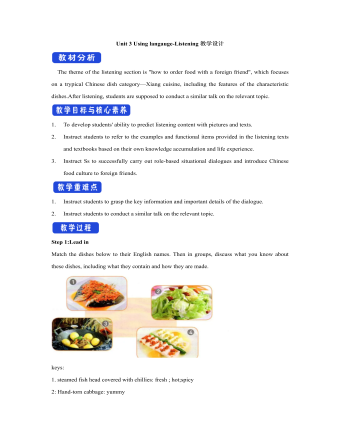
新人教版高中英语选修2Unit 3 Using langauge-Listening教学设计
1. How is Hunan cuisine somewhat different from Sichuan cuisine?The heat in Sichuan cuisine comes from chilies and Sichuan peppercorns. Human cuisine is often hotter and the heat comes from just chilies.2.What are the reasons why Hunan people like spicy food?Because they are a bold people. But many Chinese people think that hot food helps them overcome the effects of rainy or wet weather.3.Why do so many people love steamed fish head covered with chilies?People love it because the meat is quite tender and there are very few small bones.4.Why does Tingting recommend bridge tofu instead of dry pot duck with golden buns?Because bridge tofu has a lighter taste.5 .Why is red braised pork the most famous dish?Because Chairman Mao was from Hunan, and this was his favorite food.Step 5: Instruct students to make a short presentation to the class about your choice. Use the example and useful phrases below to help them.? In groups of three, discuss what types of restaurant you would like to take a foreign visitor to, and why. Then take turns role-playing taking your foreign guest to the restaurant you have chosen. One of you should act as the foreign guest, one as the Chinese host, and one as the waiter or waitress. You may start like this:? EXAMPLE? A: I really love spicy food, so what dish would you recommend?? B: I suggest Mapo tofu.? A: Really ? what's that?
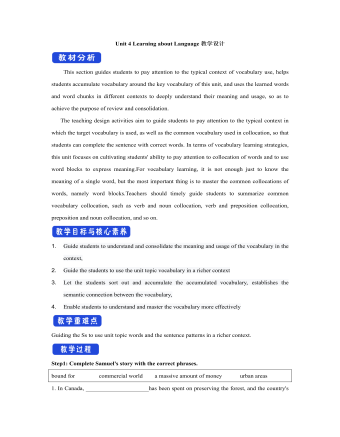
新人教版高中英语选修2Unit 4 Learning about Language教学设计
This section guides students to pay attention to the typical context of vocabulary use, helps students accumulate vocabulary around the key vocabulary of this unit, and uses the learned words and word chunks in different contexts to deeply understand their meaning and usage, so as to achieve the purpose of review and consolidation.The teaching design activities aim to guide students to pay attention to the typical context in which the target vocabulary is used, as well as the common vocabulary used in collocation, so that students can complete the sentence with correct words. In terms of vocabulary learning strategies, this unit focuses on cultivating students' ability to pay attention to collocation of words and to use word blocks to express meaning.For vocabulary learning, it is not enough just to know the meaning of a single word, but the most important thing is to master the common collocations of words, namely word blocks.Teachers should timely guide students to summarize common vocabulary collocation, such as verb and noun collocation, verb and preposition collocation, preposition and noun collocation, and so on.1. Guide students to understand and consolidate the meaning and usage of the vocabulary in the context, 2. Guide the students to use the unit topic vocabulary in a richer context3. Let the students sort out and accumulate the accumulated vocabulary, establishes the semantic connection between the vocabulary,4. Enable students to understand and master the vocabulary more effectivelyGuiding the Ss to use unit topic words and the sentence patterns in a richer context.
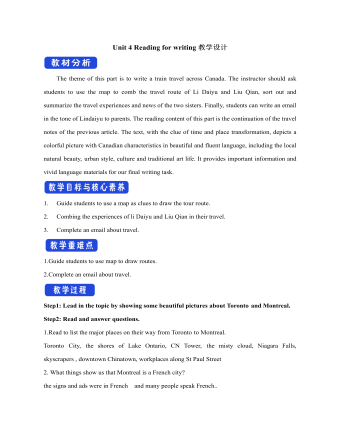
新人教版高中英语选修2Unit 4 Reading for writing教学设计
假定你是英国的Jack,打算来中国旅行,请你给你的中国笔友李华写一封信,要点如下:1.你的旅行计划:北京→泰山→杭州;2.征求建议并询问他是否愿意充当你的导游。注意:1.词数80左右(开头和结尾已给出,不计入总词数);2.可以适当增加细节,以使行文连贯。参考词汇:故宫 the Forbidden City;泰山 Mount TaiDear Li Hua,I'm glad to tell you that 'm going to visit China.First,I am planning to visit Beijing,the capitalof China,where I am looking forward to enjoying the Great Wall,the Forbidden City and somebeautiful parks.Then I intend to go to visit Mount Tai in Shandong Province.I've heard that it is one ofthe most famous mountains in China and I can't wait to enjoy the amazing sunrise there.After that,I amalso going to Hangzhou.It is said that it is a beautiful modern city with breathtaking natural sights,among which the West Lake is a well- known tourist attraction.What do you think of my travel plan? Will you act as my guide? Hope to hear from you soon.
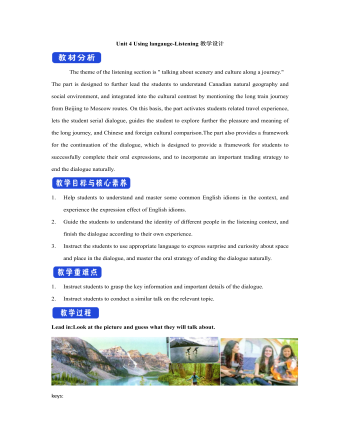
新人教版高中英语选修2Unit 4 Using langauge-Listening教学设计
The theme of the listening section is " talking about scenery and culture along a journey."The part is designed to further lead the students to understand Canadian natural geography and social environment, and integrated into the cultural contrast by mentioning the long train journey from Beijing to Moscow routes. On this basis, the part activates students related travel experience, lets the student serial dialogue, guides the student to explore further the pleasure and meaning of the long journey, and Chinese and foreign cultural comparison.The part also provides a framework for the continuation of the dialogue, which is designed to provide a framework for students to successfully complete their oral expressions, and to incorporate an important trading strategy to end the dialogue naturally.1. Help students to understand and master some common English idioms in the context, and experience the expression effect of English idioms.2. Guide the students to understand the identity of different people in the listening context, and finish the dialogue according to their own experience.3. Instruct the students to use appropriate language to express surprise and curiosity about space and place in the dialogue, and master the oral strategy of ending the dialogue naturally.1. Instruct students to grasp the key information and important details of the dialogue.2. Instruct students to conduct a similar talk on the relevant topic.
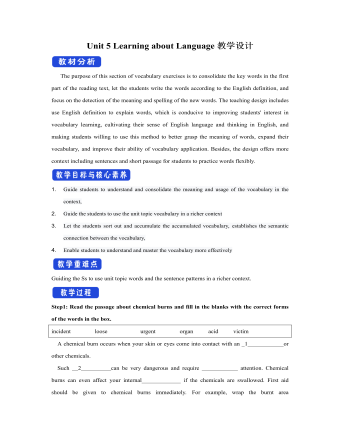
新人教版高中英语选修2Unit 5 Learning about Language教学设计
The purpose of this section of vocabulary exercises is to consolidate the key words in the first part of the reading text, let the students write the words according to the English definition, and focus on the detection of the meaning and spelling of the new words. The teaching design includes use English definition to explain words, which is conducive to improving students' interest in vocabulary learning, cultivating their sense of English language and thinking in English, and making students willing to use this method to better grasp the meaning of words, expand their vocabulary, and improve their ability of vocabulary application. Besides, the design offers more context including sentences and short passage for students to practice words flexibly.1. Guide students to understand and consolidate the meaning and usage of the vocabulary in the context, 2. Guide the students to use the unit topic vocabulary in a richer context3. Let the students sort out and accumulate the accumulated vocabulary, establishes the semantic connection between the vocabulary,4. Enable students to understand and master the vocabulary more effectivelyGuiding the Ss to use unit topic words and the sentence patterns in a richer context.Step1: Read the passage about chemical burns and fill in the blanks with the correct forms of the words in the box.
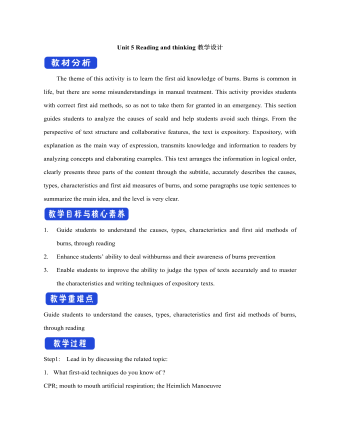
新人教版高中英语选修2Unit 5 Reading and thinking教学设计
The theme of this activity is to learn the first aid knowledge of burns. Burns is common in life, but there are some misunderstandings in manual treatment. This activity provides students with correct first aid methods, so as not to take them for granted in an emergency. This section guides students to analyze the causes of scald and help students avoid such things. From the perspective of text structure and collaborative features, the text is expository. Expository, with explanation as the main way of expression, transmits knowledge and information to readers by analyzing concepts and elaborating examples. This text arranges the information in logical order, clearly presents three parts of the content through the subtitle, accurately describes the causes, types, characteristics and first aid measures of burns, and some paragraphs use topic sentences to summarize the main idea, and the level is very clear.1. Guide students to understand the causes, types, characteristics and first aid methods of burns, through reading2. Enhance students’ ability to deal withburnss and their awareness of burns prevention3. Enable students to improve the ability to judge the types of texts accurately and to master the characteristics and writing techniques of expository texts.Guide students to understand the causes, types, characteristics and first aid methods of burns, through readingStep1: Lead in by discussing the related topic:1. What first-aid techniques do you know of ?CPR; mouth to mouth artificial respiration; the Heimlich Manoeuvre
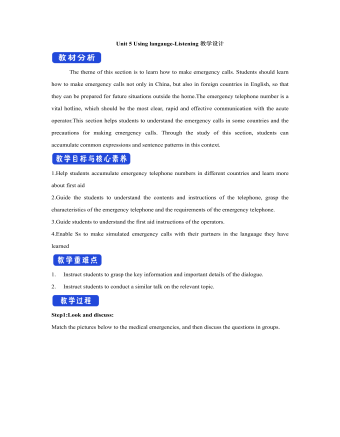
新人教版高中英语选修2Unit 5 Using langauge-Listening教学设计
The theme of this section is to learn how to make emergency calls. Students should learn how to make emergency calls not only in China, but also in foreign countries in English, so that they can be prepared for future situations outside the home.The emergency telephone number is a vital hotline, which should be the most clear, rapid and effective communication with the acute operator.This section helps students to understand the emergency calls in some countries and the precautions for making emergency calls. Through the study of this section, students can accumulate common expressions and sentence patterns in this context. 1.Help students accumulate emergency telephone numbers in different countries and learn more about first aid2.Guide the students to understand the contents and instructions of the telephone, grasp the characteristics of the emergency telephone and the requirements of the emergency telephone.3.Guide students to understand the first aid instructions of the operators.4.Enable Ss to make simulated emergency calls with their partners in the language they have learned1. Instruct students to grasp the key information and important details of the dialogue.2. Instruct students to conduct a similar talk on the relevant topic.Step1:Look and discuss:Match the pictures below to the medical emergencies, and then discuss the questions in groups.
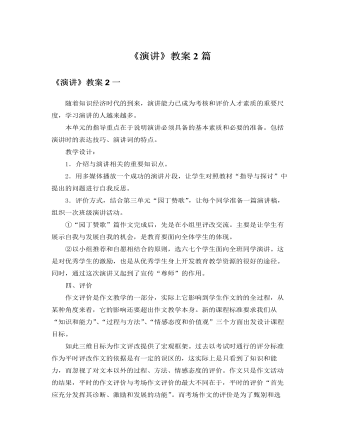
人教版高中语文必修2《演讲》教案2篇
一个世纪前,一位了不起的美国人签署了奴隶解放宣言,而我们今天就站在他的塑像下面。对于千千万万身受不公正待遇之苦的黑奴来说,这份划时代的文件,是一座光芒万丈的希望灯塔,是结束他们被束缚之漫漫长夜的快乐黎明。我有一个梦,有朝一日在乔治亚州的丘陵地带,奴隶的后代与奴隶主的后代,将能够兄弟般地相处。我有一个梦,有朝一日甚至密西西比州,这个充满不平与压迫的州,将转化成一片自由与公正的绿洲。我有一个梦,我的四个孩子,有朝一日将可以生活在这样一个国度里:在此人们不是根据他们的肤色,而是根据他们的品行来衡量他们。我今天有一个梦!我有一个梦,有朝一日在阿拉巴马州,尽管目前有许多恶毒的种族主义者,尽管州长叫嚷着要与联邦政府对抗,有朝一日在阿拉巴马州,黑人孩子与白人孩子将会像兄弟姊妹那样亲密无间。
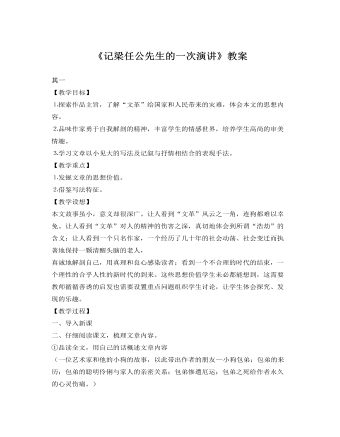
人教版高中语文《记梁任公先生的一次演讲》教案
十、教学后记:这是我实习中上的第一堂课,由于没有经验,对时间的把握不好,课堂前半部分留给学生思考回答问题的时间太多了,以至于没有完成本课时的教学内容,对《箜篌引》、《桃花扇》、《闻官军收河南河北》内容的补充要留到下节课才能完成。但课堂过程中以讨论和结果发布会的形式非常能调动学生的学习积极性,这节课学生的参与度很高,绝大部分的同学都能积极思考,并敢于回答问题。但是在学生回答问题后,有些答案很好,也是我没有思考到的。但是除了简单的表扬鼓励外,我不善于把学生的思考结果与自己的板书设计结合起来,授课过程中比较拘泥于教案,显得不够灵活。总的来说,这节课的优点是教态自然、大方,声音清晰洪亮,能调动学生学习的积极性,不足在于时间掌握不好,拘泥于教案。

人教版高中语文《在马克思墓前的讲话》教案
【教学过程】一、导入:(大屏幕显示马克思肖像)今年的5月5日,是这位无产阶级革命导师的186周年纪念日。在新世纪来临之际,英国著名的广播公司BBC举办了一次千年最伟大思想家评选活动,结果马克思位居爱因斯坦、牛顿、达尔文等巨人之前,被评为过去千年最伟大的思想家。为什么他会获得如此高的评价呢?因为正是这样一位巨人,他总结了资本主义社会乃至整个人类社会的历史发展规律,推动了无产阶级革命进程,创立了伟大的马克思主义理论。今天我们一起来学习恩格斯的《在马克思墓前的讲话》,并悼念这位无产阶级革命的伟大导师。二、学生快速阅读课文,请学生概括课文的写作思路。明确:逝世情况——伟大贡献——巨大影响三、具体研习课文1、分析第一部分:(下面我们具体研析课文)学生齐读第一段,多媒体展示马克思逝世情景。
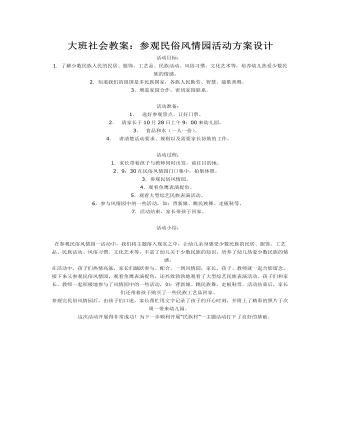
大班社会教案:参观民俗风情园活动方案设计
1.了解少数民族人民的民居、服饰、工艺品、民族活动、风俗习惯、文化艺术等,培养幼儿热爱少数民族的情感。 2.知道我们的祖国是多民族国家,各族人民勤劳、智慧、能歌善舞。 3、增进家园合作,密切家园联系。 活动准备: 1. 选好参观景点、订好门票。 2. 请家长于10月28日上午9:00来幼儿园。 3. 食品和水(一人一份)。 4. 讲清楚活动要求、规则以及需要家长协助的工作。
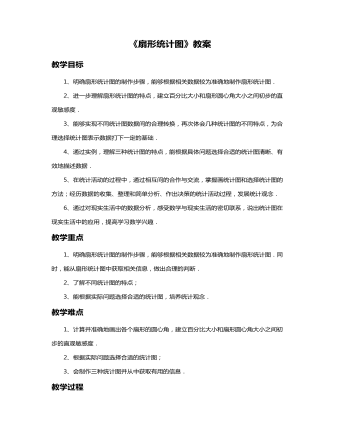
扇形统计图教案教学设计
教学目标1、明确扇形统计图的制作步骤,能够根据相关数据较为准确地制作扇形统计图.2、进一步理解扇形统计图的特点,建立百分比大小和扇形圆心角大小之间初步的直观敏感度.3、能够实现不同统计图数据间的合理转换,再次体会几种统计图的不同特点,为合理选择统计图表示数据打下一定的基础.4、通过实例,理解三种统计图的特点,能根据具体问题选择合适的统计图清晰、有效地描述数据.5、在统计活动的过程中,通过相互间的合作与交流,掌握画统计图和选择统计图的方法;经历数据的收集、整理和简单分析、作出决策的统计活动过程,发展统计观念.6、通过对现实生活中的数据分析,感受数学与现实生活的密切联系,说出统计图在现实生活中的应用,提高学习数学兴趣.
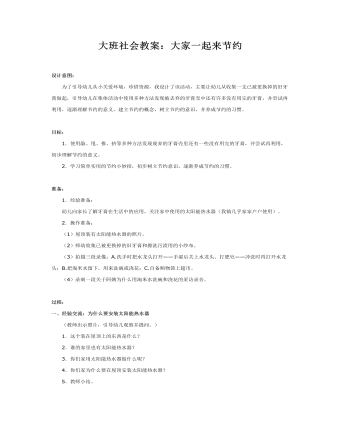
大班社会教案:大家一起来节约
目标:1.使用敲、甩、推、挤等多种方法发现废弃的牙膏壳里还有一些没有用完的牙膏,并尝试再利用,初步理解节约的意义。2.学习简单实用的节约小妙招,初步树立节约意识,逐渐养成节约的习惯。 准备:1.经验准备: 幼儿向家长了解牙膏在生活中的应用,关注家中使用的太阳能热水器(我镇几乎家家户户使用)。2.操作准备: (1)屋顶装有太阳能热水器的照片。 (2)师幼收集已被更换掉的旧牙膏和擦洗污渍用的小纱布。 (3)拍摄三段录像:A.洗手时把水龙头打开——手湿后关上水龙头、打肥皂——冲洗时再打开水龙头;B.把淘米水留下,用来洗碗或浇花;C.自备购物袋上超市。 (4)录制一段关于阿姨为什么用淘米水洗碗和浇花的采访录音。
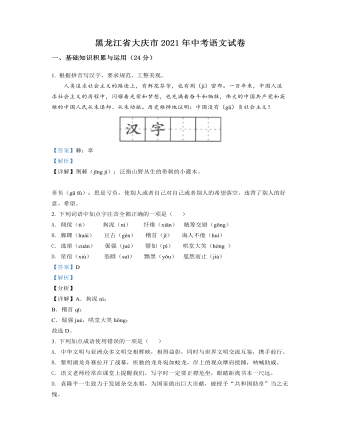
黑龙江省大庆市2021年中考语文试题(解析版)
有趣的人,对生活抱有大爱。有时,即便身处逆境,他们也能过得兴致盎然;即便眼前满是苟且,他们也总能找到诗和远方。苏轼就是个十足有趣的人。被贬官后,他没有愁肠百结,而是发现了生活的真和趣。在黄州,他把“价钱如泥土”“贵者不肯吃,贫者不解煮”的猪肉,做成了色、香、味俱全的“东坡肉”,并撰文《猪肉颂》,讲述烧制心得。
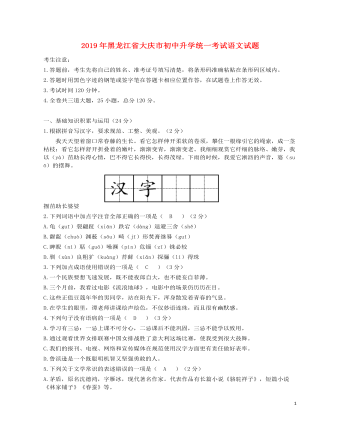
黑龙江省大庆市2019年中考语文真题试题
关于风筝的起源有很多说法,比如斗笠、树叶说,认为风筝的出现受到被风吹起的斗笠、树叶的启发,还有帆船、帐篷说,飞鸟说等。观点虽不统一,但风筝很早就出现在中国并无异议。《韩非子·外储说左上》中记载“墨子为木鸢,三年而成,飞一日而败。弟子曰:‘先生之巧,至能使木鸢飞。’”可见春秋战国时期已有风筝,不过为木质。随着造纸术的发展,从唐朝开始,纸糊的风筝逐渐兴起。当了宋代,放风筝已经成为当时人们喜爱的户外活动。明清时期,风筝的制作技艺、装饰技艺得到空前发展。至清朝道光年间达到鼎盛。

中班体育游戏教案:熊来了
活动准备:“熊”头饰一只,圈划幼儿活动范围和“熊家”活动过程: 1、导入活动。 教师:“如果你突然遇到一头大狗熊,你该怎么样,它才不会吃你?” 幼儿讨论提出意见。 2、设置情境,观察讨论熊的习性。 (1)请另一位老师扮成熊,听到主 班 老师说“哎呀!瞧,我们班来了一只大狗熊!你们快用你刚才的办法试试看,看它会不会吃你!”就出现。 幼儿尝试自己的办法,熊将出声的,动的幼儿抓走。 教师请没被抓走的幼儿介绍自己的方法:没有动,没有出声音等。
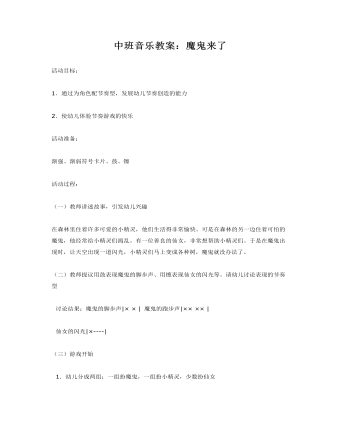
中班音乐教案:魔鬼来了
2.使幼儿体验节奏游戏的快乐活动准备:渐强、渐弱符号卡片、鼓、镲活动过程:(一)教师讲述故事,引发幼儿兴趣在森林里住着许多可爱的小精灵,他们生活得非常愉快。可是在森林的另一边住着可怕的魔鬼,他经常给小精灵们捣乱。有一位善良的仙女,非常想帮助小精灵们。于是在魔鬼出现时,让天空出现一道闪光,小精灵们马上变成各种树,魔鬼就没办法了。
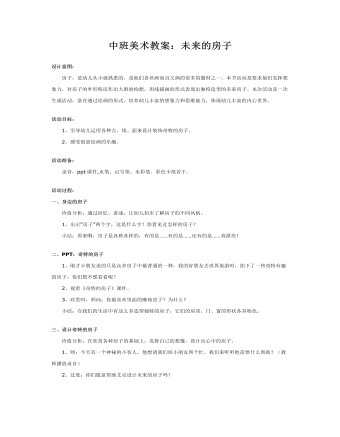
中班美术教案:未来的房子
活动目标:1、引导幼儿运用各种点、线、面来设计装饰奇特的房子。2、感受创意绘画的乐趣。活动准备: 录音,ppt课件,水笔、记号笔、水彩笔、彩色卡纸若干。活动过程:一、身边的房子 价值分析:通过回忆、讲述,让幼儿初步了解房子的不同风格。1、出示“房子”两个字,这是什么字?你看见过怎样的房子? 小结:原来啊,房子是各种各样的,有的是……有的是……还有的是……真漂亮!二、PPT:奇特的房子1、刚才小朋友说的只是众多房子中最普通的一种,我的好朋友去世界旅游时,拍下了一些奇特有趣的房子,你们想不想看看呢?2、观看《奇特的房子》课件。3、欣赏时,师问:你最喜欢里面的哪座房子?为什么? 小结:在我们的生活中有这么多造型独特的房子,它们的房顶、门、窗的形状各具特色。
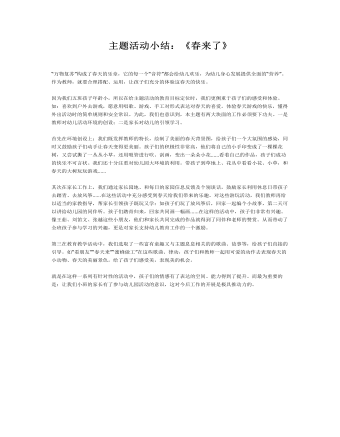
中班主题课件教案:春来了
因为我们五班孩子年龄小,所以在给主题活动的教育目标定位时,我们更侧重于孩子们的感受和体验。如:喜欢到户外去游戏,愿意用唱歌、游戏、手工对形式表达对春天的喜爱。体验春天游戏的快乐,懂得外出活动时的简单规则和安全常识。为此,我们也意识到,本主题有两大块面的工作必须要下功夫。一是教师对幼儿活动环境的创设;二是家长对幼儿的引领学习。首先在环境创设上:我们既发挥教师的特长,绘制了美丽的春天背景图,给孩子们一个大氛围的感染,同时又鼓励孩子们动手让春天变得更美丽。孩子们的积极性非常高,他们将自己的小手印变成了一棵棵花树,又尝试撕了一丛丛小草,还用吸管进行吹、刮画,变出一朵朵小花……看着自己的作品,孩子们成功的快乐不可言状。我们还十分注重对幼儿园大环境的利用。带孩子到草地上、花丛中看看小花、小草,和春天的大树玩玩游戏……
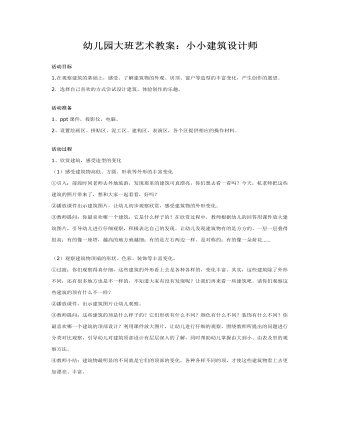
幼儿园大班艺术教案:小小建筑设计师
活动准备 1、ppt课件,投影仪,电脑。 2、设置绘画区、拼贴区、泥工区、建构区、表演区,各个区提供相应的操作材料。 活动过程 1、欣赏建筑,感受造型的变化 (1)感受建筑物高低、方圆、形状等外形的丰富变化 ①引入:前段时间老师去外地旅游,发现那里的建筑可真漂亮,你们想去看一看吗?今天,杭老师把这些建筑的照片带来了,想和大家一起看看,好吗? ②播放课件出示建筑图片,让幼儿初步观察欣赏,感受建筑物的外形变化。 ③教师提问:你最喜欢哪一个建筑,它是什么样子的?在欣赏过程中,教师根据幼儿的回答用课件放大建筑图片,引导幼儿进行仔细观察,积极表达自己的发现。让幼儿发现建筑物有的是方方的、一层一层叠得很高;有的像一座塔,越高的地方就越细;有的是左右两边一样、是对称的;有的像一朵荷花……





















